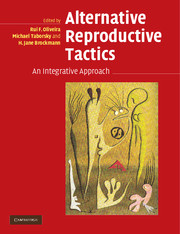Book contents
- Frontmatter
- Contents
- List of contributors
- Preface
- 1 The evolution of alternative reproductive tactics: concepts and questions
- PART I ULTIMATE CAUSES AND ORIGINS OF ALTERNATIVE REPRODUCTIVE TACTICS
- PART II PROXIMATE MECHANISMS OF ALTERNATIVE REPRODUCTIVE TACTICS
- PART III TAXONOMIC REVIEWS OF ALTERNATIVE REPRODUCTIVE TACTICS
- 8 Alternative reproductive tactics in insects
- 9 The expression of crustacean mating strategies
- 10 Alternative reproductive tactics in fish
- 11 Alternative reproductive tactics in amphibians
- 12 Alternative reproductive tactics in reptiles
- 13 Alternative reproductive tactics in birds
- 14 Alternative reproductive tactics in nonprimate male mammals
- 15 Alternative reproductive tactics in primates
- PART IV EMERGING PERSPECTIVES ON ALTERNATIVE REPRODUCTIVE TACTICS
- Index of species
- Subject index
- References
15 - Alternative reproductive tactics in primates
Published online by Cambridge University Press: 10 August 2009
- Frontmatter
- Contents
- List of contributors
- Preface
- 1 The evolution of alternative reproductive tactics: concepts and questions
- PART I ULTIMATE CAUSES AND ORIGINS OF ALTERNATIVE REPRODUCTIVE TACTICS
- PART II PROXIMATE MECHANISMS OF ALTERNATIVE REPRODUCTIVE TACTICS
- PART III TAXONOMIC REVIEWS OF ALTERNATIVE REPRODUCTIVE TACTICS
- 8 Alternative reproductive tactics in insects
- 9 The expression of crustacean mating strategies
- 10 Alternative reproductive tactics in fish
- 11 Alternative reproductive tactics in amphibians
- 12 Alternative reproductive tactics in reptiles
- 13 Alternative reproductive tactics in birds
- 14 Alternative reproductive tactics in nonprimate male mammals
- 15 Alternative reproductive tactics in primates
- PART IV EMERGING PERSPECTIVES ON ALTERNATIVE REPRODUCTIVE TACTICS
- Index of species
- Subject index
- References
Summary
CHAPTER SUMMARY
A wide diversity of reproductive strategies and alternative reproductive tactics (ARTs) have evolved to promote the reproductive success of individual male and female primates. Intraspecific variation in male mating strategies has received far more attention than flexibility of reproductive behavior in female primates. However, female primates may also employ ARTs, with important implications for lifetime reproductive success. ARTs in primates tend to be limited to behavior, gonads, and physiology and are rarely associated with dramatic alternative morphologies, although striking exceptions to this rule exist. This is likely due to the advantages of plasticity and the lower costs of adjustment according to changing characteristics of the individual and social conditions. Most ARTs in primates appear to be “best-of-a-bad-job” phenotypes, whereby inferior individuals, or those in a suboptimal situation, make the most of any opportunity available to gain reproductive success. With the exception of female reproductive suppression in common marmosets, relatively little is known about the life-history pathways underlying ARTs and the factors that determine their expression. Finally, male and female reproductive strategies are intricately linked in primates, and interactions between the sexes play an important role in the evolution of primate ARTs.
INTRODUCTION
The adaptive adjustment of individuals to differences in their social and ecological environment is expected to lead to intraspecific variation in reproductive tactics (Rubenstein 1980, Dunbar 1982, Clutton-Brock 1989, Davies 1991, Lott 1991).
- Type
- Chapter
- Information
- Alternative Reproductive TacticsAn Integrative Approach, pp. 373 - 398Publisher: Cambridge University PressPrint publication year: 2008
References
- 37
- Cited by

